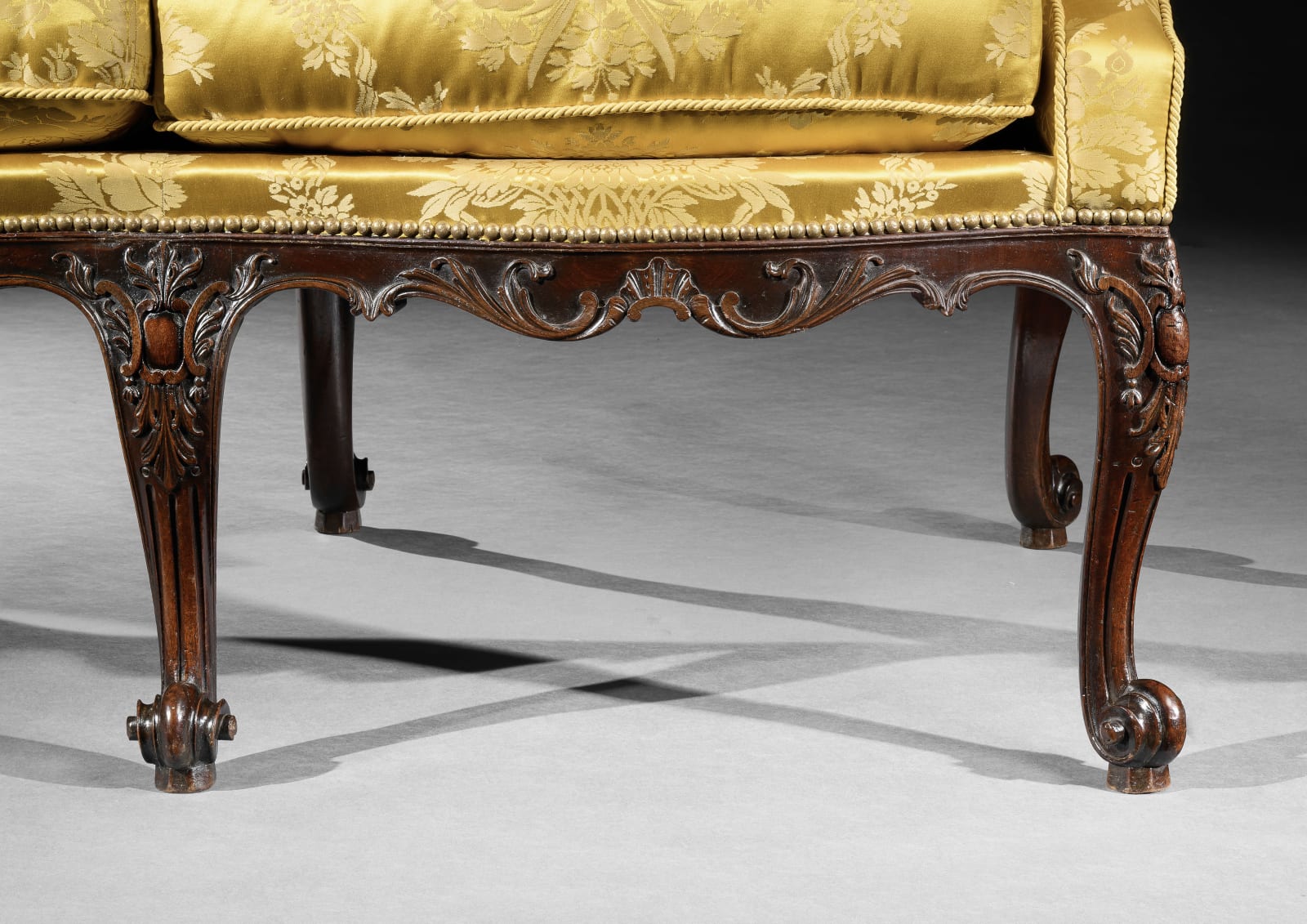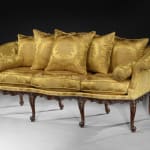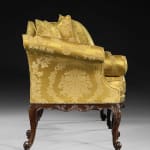A GEORGE II MAHOGANY SETTEE ATTRIBUTED TO PAUL SAUNDERS
W: 84.25" / 214cm
D: 33.5" / 85m
Further images
Provenance
Private Collection: London, UKThe distinctive cabochon carved between scrolling acanthus at the knee of the cabriole leg is a hallmark of seat furniture closely associated with the workshop of Paul Saunders, one of the leading cabinetmakers in mid-18th century London. This motif appears prominently in a number of documented high-level commissions, executed here with an exceptional clarity and fluidity that speaks to the superb quality of both material and craftsmanship. The carving is remarkably crisp — the scrolls deeply undercut, the cabochons richly modelled — and animated by a confident rhythm that reflects the hand of a top-tier carver. These elements are brought to life by the use of finely figured mahogany, a dense, richly hued timber prized above all others for its durability, lustre, and capacity for holding intricate detail. Few materials better convey the opulence and sculptural potential of the Rococo idiom.
This specific leg pattern and ornamental vocabulary can be traced to a number of major commissions undertaken by Saunders, including the set of “12 chairs, mahog. frames / Gilt” and “10 Elbow / chairs with carved and gilt / frames” supplied to Thomas Coke, 1st Earl of Leicester, for Holkham Hall in 1757. On 11 June of that year, ‘Mr. Saunders’ charged £39 10s. 3d. and £41 18s. respectively for the two groups. The same detail appears again on the “2 large sophas” supplied for the Gallery at Holkham, invoiced at £74 0s. 4d.¹
A suite featuring the same leg and apron design was also supplied to Thomas Thynne, 3rd Viscount Weymouth, at Longleat, comprising at least eight armchairs and two settees. These are almost certainly included in the substantial payments made to Saunders and recorded in the Viscount’s Drummonds Bank account: £556 15s. in November 1757 and a further £300 in November 1759.² The same cabochon and scroll motif also appears on an en suite library table, suggesting a unified interior scheme.
Another closely related suite — now partly dispersed — was supplied to Grimsthorpe Castle, with surviving examples in situ and others having entered the collections of Irwin Untermyer and Ann and Gordon Getty, where they have been widely illustrated.³ In all these examples, Saunders’ distinct design language is evident: triple-fluted legs, scrolled toes, and shaped aprons centred by shell or wheatsheaf motifs flanked by stylised acanthus.⁴ These motifs are used not as formula but with variation and freedom, lending each piece a sense of individuality while maintaining a coherent visual identity across a suite.
As a cabinetmaker, Paul Saunders was among the most accomplished and sought-after artisans of his time. Operating first from Soho and later from Long Acre, he catered to a discerning clientele of aristocratic patrons, including commissions for Holkham, Longleat, Grimsthorpe, Lowther Castle, and others. Though less widely known than his contemporary Thomas Chippendale, Saunders was a master of the carved Rococo idiom, his ability to deliver large-scale, architecturally coordinated interiors, and his access to the finest joiners, carvers, and materials position him at the very forefront of English furniture design in the 1750s and 1760s.
In this context, a settee of this scale and ambition is a true rarity. Unlike chairs — which were made in larger numbers and more likely to survive — large settees were generally bespoke creations, made in very small numbers for specific interiors such as grand saloons or galleries. Their cost, size, and function as centrepieces of elite decorative schemes meant that few were made and even fewer survive today. This example, with its generous proportions, serpentine rail, and boldly sculpted legs, not only embodies the luxurious aesthetic of the English Rococo but also survives in exceptional condition — a testament to its quality and the esteem in which it has long been held.
Comparable examples include a settee with identical carving sold at Christie’s, Jasper Conran: The Collection Part I, 14 September 2021, lot 176, for £93,750, and a pair of chairs with the same leg and apron design — formerly in the collection of Sir Martyn Beckett, Bt., M.C. — which sold at Sotheby’s London, 18 November 2008, lot 348, for £94,850, and again at Sotheby’s New York, 16 October 2009, lot 135, for $134,500.
With its commanding scale, sculptural richness, and use of exceptiona timber, this settee ranks among the most significant survivals of mid-Georgian seat furniture and stands as a powerful expression of refinement and taste in the Rococo age.





